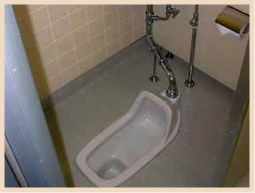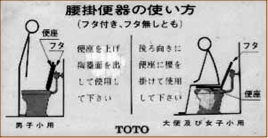
Todd Jay Leonard, Blog


Before my mother’s first trip to Japan some 15 years ago, one main concern I had with her visit had nothing to do with her not being able to use chopsticks, eat the food, speak the language or climb the countless stairs to take the trains and subways — I worried about being able to secure appropriate toilet facilities, acceptable enough for my mother’s discerning tastes, at all the points of interest we were scheduled to visit.
I even went as far as to scout out places before her arrival in order to make sure proper facilities were available. Fortunately, today, this type of concern is largely unfounded as the vast majority of public restrooms are now clean and modern, often being equipped with at least one Western-style toilet.
When I first arrived in Japan, however, this was not the case. Many public toilets were not connected to sewage systems, which meant the stench was staggering, especially during the height of summer; also, the vast majority of toilets were the traditional “squat” type of toilet that required a certain amount of dexterity and stamina, not to mention balance, to accomplish the given task at hand.
Western tourists who visit Japan often have a fear (unfounded in my opinion) of using a Japanese-style toilet. To be honest, I prefer the traditional toilets because they are much cleaner and healthier to use than the common Western-style chair-type toilets. With squat toilets, at no time does one’s body ever touch any part of the toilet, so the user avoids any potentially unhygienic contact with a surface someone else has just touched or used.
When a dear friend of mine from Shelbyville came to visit me in Japan, she proudly proclaimed as we prepared to leave for Tokyo at the end of her visit that she had successfully avoided using a Japanese-style toilet throughout her entire two-week visit. Her jubilant proclamation was a bit premature.
The overnight sleeper we took to Tokyo, an older style train, was equipped only with traditional squat-type toilets. The train ride is around 12 hours long. You do the math.
My friend finally couldn’t wait any longer and decided she had to venture into the toilet car to do her business. How she did it, I have no idea, but she claimed she was able to use the squat toilet without squatting… which means she must have used the toilet standing up.
This is all the more amazing when considering she did this on a moving train, which requires even more skill because the train is constantly swaying back and forth. Luckily, a handlebar is located on both sides so users can steady themselves while using it on a moving train.
Generally speaking, toilets in Japan have certainly come a long way since the early days when the Western-style toilet was first introduced. In many ways, the Japanese chair-type toilet has now surpassed in comfort and styles those of the West.
One unique feature that is standard on most toilets here are water-saving measures. The flush mechanism allows the user to choose between a powerful or a weaker flush, depending upon what is being flushed. Also, on top of the tank is a sink where the water that is used to fill the tank is first utilized by the user to wash his/her hands before it drains into the tank to be recycled. This same water is then used for the next flush.
One common practice here amongst women is the habit of repeatedly flushing a toilet over and over while tinkling. A Japanese woman is much too modest to risk having someone hear her using the toilet. So, the water saving measure (incorporated into the design of the toilet) was rendered meaningless.
Not to fear. Japan with all of its innovative ingenuity came up with a workable solution — piping in the sound of running water into women’s toilets via speakers loud enough to muffle any individual sounds.
Another gadget that was widely installed in women’s toilets was a push button system that mimicked the sound of a flushing toilet, used at the discretion of the user.
This solved the problem of having gallons upon gallons of water being wastefully flushed down the toilet. Women could tinkle with the reassurance of knowing that no one could hear what they were doing.
In the past few years, public toilets have gotten very swanky in many respects. It is not at all uncommon to find toilets with built in “washlet” or bidet systems that allow users to wash their undersides after using the toilet, with an extra setting exclusively for women.
Many elderly people here, however, would rather not have all the bells and whistles, preferring the simple squat toilet. But modern technology has forced them, in a pinch, to use the newfangled contraptions. Nearly always, thankfully, directions with an illustration are posted on the wall featuring stick figures properly using the Western-style toilet for those who may not be familiar or comfortable with the concept.
One luxury that I cannot live without, and one which most of you may think is frivolous, is the heated toilet seat. Living in snow country, without the luxury of central heating, means that the toilet area is not heated. Believe me, a heated seat is not an extravagance.
On visits home, that initial shock one receives when sitting on a cold toilet seat reminds me of how wonderful this little invention truly is. Once you have experienced the joy of a heated toilet seat, a normal seat is quite meager in comparison.
By TODD JAY LEONARD
Columnist
Japan’s toilet culture flushes ahead of U.S.
Monday, March 13, 2006









